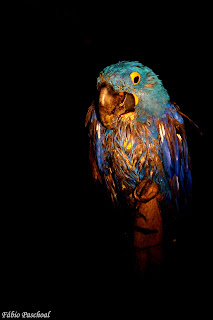Nome: Arara Azul
English name: Hyacinth Macaw
Family: Psittacidae
Species: Anodorhynchus hyacinthinus
IUCN Status: Endengered
IUCN Status: Endengered
Pictures taken at: Pantanal
Natural History: The Hyacinth Macaw is the largest macaw in the world. 90% of their nests are found in one species of tree, the Manduvi, which has a sofht bark that the macaws can carve. However, they never start a nest from the beginning. They must find a hole in the tree that they will carve to make it bigger. The hole can be made for a woodpecker or for a branch that has fallen.
In Pantanal It feeds on extremely hard seeds of two kinds of palm trees: Acuri, that has fruits all over the year, and Bocaiuva, that is available for 6 months of the year. Unfortunately is an endangered species due manly to deforestation, that take down the trees that they need for nesting and for food. The illegal animal trade and craft work made with their feathers are also major threats.
Hyacinth Macaw feeding chick
Arara Azul alimentando filhote
They are monogamous, which means that after they find a partner they stay with the partner for the rest of their lives. The parents stay with the chick for one and a half years teaching the places to find food and how to break the nuts.
Hyacinth Macaws at Bocaiuva
Araras Azuis em Bocaiuva
The Hyacint Macaw Project (http://www.bluemacaws.org/neiva.htm) is doing an excellent job in the Pantanal installing artificial nests that increase the number of cavities that the macaws can use. They also check the chicks to see if they are healthy. After 20 years of project the population of Hyacinth Macaws has increased from 1500 to more than 6000. So thanks to them it's easy to see those wonderful Macaws painting the Pantanal's sky of blue.
Installation of the artificial nest
Instalação do ninho artificial
Checking the chick
Checando o Filhote
Hyacinth Macaws on the nest
Araras Azuis no ninho
História Natural: A maior arara do mundo! Infelizmente é um animal ameaçado de extinção devido ao desmatamento e ao tráfico de animais entre outros fatores. Coloca mais de 90% de seus ovos em uma árvore específica, o Manduvi (também pode utilizar a Ximbuva). No entanto, a arara azul nunca começa um ninho em uma árvore, é necessário que o buraco (que pode surgir com um galho quebrado ou ser feito por um pica pau) exista para que a arara comece a moldar a entrada do ninho. Ela se alimenta somente das sementes (muito duras) de duas palmeiras: o acuri, que frutifica o ano inteiro e a bocaiuva que da fruto durante seis meses do ano. São animais monogâmicos e depois que formam um par permanecem unidos até o final da vida. Colocam em média 3 ovos, mas na maioria das vezes só um filhote sobrevive. Existe cuidado parental, sendo que o filhote permanece com os pais por mais ou menos um ano e meio.
O Projeto Arara Azul (http://www.projetoararaazul.org.br/arara/) vem fazendo um excelente trabalho no Pantanal instalando ninhos artificias ninhos artificias que aumentam a disponibilidade de cavidades que as araras podem utilizar. Também checam os filhotes para ver se estão saudáveis. Depois de 20 anos de projeto a população de Araras Azuis foi de 1500 para 6000 indivíduos. Graças a eles é fácil observar esses maravilhas colorindo o céu do Pantanal de azul.








No comments:
Post a Comment